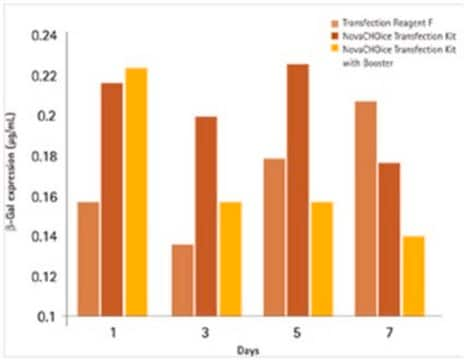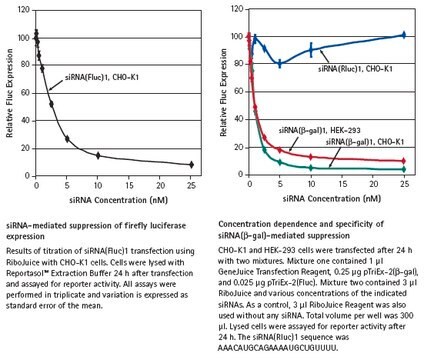L3287
Escort™ IV Transfection Reagent
Lipid reagent for transient and stable transfection of mammalian and insect cells.
Synonyme(s) :
Gene delivery
About This Item
Produits recommandés
Qualité
for molecular biology
Niveau de qualité
Forme
liquid (aqueous solution)
Utilisation
1 mL sufficient for 160-500 transfections
Concentration
1 mg/mL
Technique(s)
transfection: suitable
Température de stockage
2-8°C
Catégories apparentées
Description générale
Application
Caractéristiques et avantages
- Suitable for stable and transient transfection
- Optimized for a wide variety of cell lines
- Low toxicity
- Compatible with both serum and serum-free transfection protocols
- Ideal for Sf9, Sf21 and S2 insect cells
Composants
1 mg/mL total lipid in water
Note the identity of the lipids used in Escort™ IV is confidential.
Attention
Principe
Informations légales
Produit(s) apparenté(s)
Code de la classe de stockage
10 - Combustible liquids
Classe de danger pour l'eau (WGK)
WGK 3
Point d'éclair (°F)
Not applicable
Point d'éclair (°C)
Not applicable
Équipement de protection individuelle
Eyeshields, Gloves
Certificats d'analyse (COA)
Recherchez un Certificats d'analyse (COA) en saisissant le numéro de lot du produit. Les numéros de lot figurent sur l'étiquette du produit après les mots "Lot" ou "Batch".
Déjà en possession de ce produit ?
Retrouvez la documentation relative aux produits que vous avez récemment achetés dans la Bibliothèque de documents.
Les clients ont également consulté
Articles
Transfection introduces genetic material into cells, aiding research in gene expression and cell biology.
This brief webinar provides an overview of what transfection is and the methods that are used to introduce DNA or RNA into eukaryotic cells.
Protocoles
The product bulletin providin detailed use protocol for easy DNA transfection.
Product manual provides detailed protocol for easy DNA transfection.
Universal Transfection Reagent enables efficient nucleic acid delivery into various cells, compatible with different cell culture conditions.
Calcium phosphate transfection is a common method for the introduction of DNA into eukaryotic cells. This protocol can be optimized for use with a wide variety of cell types.
Contenu apparenté
Browse our convenient transfection reagent selection guide to match the best reagent for your specific cell line and application needs.
Notre équipe de scientifiques dispose d'une expérience dans tous les secteurs de la recherche, notamment en sciences de la vie, science des matériaux, synthèse chimique, chromatographie, analyse et dans de nombreux autres domaines..
Contacter notre Service technique











